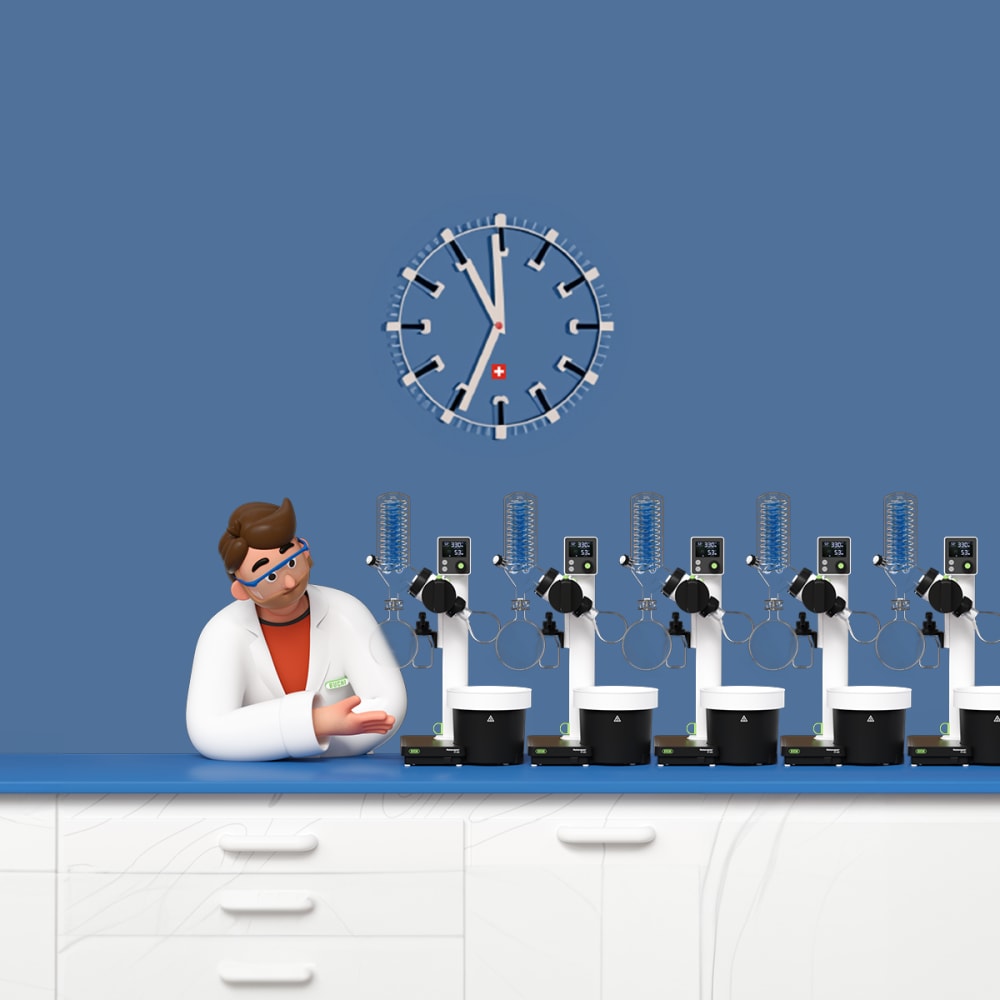Tailored Technology: Exploring Rotary Evaporator Integration

Hello, and welcome back to the “Colorful Researchers” blog. In my first two evaporation blogs, I discussed the components of a Rotavapor®, including the importance of glass and how the physical, mechanical, and digital components work together. For this blog, I want to focus on integration. Here at BUCHI, we have a full suite of Rotavapors® suited to a range of tasks. Deciding which instrument is suitable for your needs depends on a number of factors, like use case, workflow, lab space, etc. Navigating the sea of possibilities is difficult, and time is ticking, so let’s dive right in!
Time-Honored Tools
Rotary evaporators have been a staple in laboratories for decades, and the distillation equipment that preceded the technology dates back millennia. However, the equipment is now used for purposes not considered when Mr. Buchi initially commercialized it.
I am a big fan of watches; after all, I am Swiss! And I see many parallels between the Swiss watch industry and the rotary evaporator market. Every year in Geneva, the “watches and wonders” event showcases the latest horological innovations. I find it incredible to see improvements still being made to portable timepieces made possible by the invention of the mainspring in the early 15th century. And just as the use cases for rotary evaporators have changed, so too has the use of watches. Portable watches became invaluable to navigators with the development of the marine chronometer in the 18th century. This innovation was critical in solving the problem of determining longitude at sea. Similarly, integrating vacuum pumps and controllers with rotary evaporators improved the efficiency and versatility, allowing for more controlled and refined processes suitable for complex distillation needs in research and industrial settings.
Custom Craftsmanship
Integration is also important in both industries. Even simple watches that just tell the time require differences depending on the environment where they are being used. There are thick diver watches that can operate in the deep sea, large-face watches for pilots with large numerals so they can easily be read at a glance, and elegant dress watches that are thinner, so they fit under a cuff. Similarly, at BUCHI, we have ATEX-rated explosion-proof Rotavapors® for hazardous environments and IP-rated instruments invaluable in dusty environments where there is a risk of deflagration. Both are evaporation units but uniquely designed to perform in different environments.
Of course, in addition to the environment, there is the application. A racing driver may require a timepiece, not to track the time of day but the time of a lap. Over the years, more complications have been incorporated to add more functionality to watches. One of the highlights of this year's ‘Watches and Wonders’ was Vacheron Constantin's presentation of the world’s most complicated watch, Les Cabinotiers, which comprises 63 complications and 2,877 components. “Complications” have also been added to rotary evaporators over the years to increase their functionality. The need to evaporate to specific volumes led to parallel instruments and the addition of level sensors and numerous other features I mentioned in my previous blog.
The Universality of Precision
Somewhat ironically, watches are timeless. Many old watches, with the proper maintenance, still function and wouldn’t look out of place on a wrist today—the same cannot be said for clothes. As Oscar Wilde said,
“Fashion is merely a form of ugliness so absolutely unbearable that we have to alter it every six months!”
When form follows function, objects stand the test of time. Many of my colleagues and I are always surprised and happy when we see old BUCHI Rotavapors® still in use. Some instruments from the 1970s are still in use today. Of course, modern instruments have more features, automation capabilities, and the like, but a more straightforward instrument is ideal for basic tasks and educational purposes.
In fact, when we come across older instruments, it is often in academic institutions that don’t have the budget or use cases to justify buying the latest instruments with advanced features. A budding horologist who wants to learn the inner mechanics of a watch would not look inside the inexplicably complex workings of ‘Les Cabinotiers’; they would start with a simple mechanism to understand the basics.
Back to Basics
This idea of returning to the fundamentals guided us in developing the Rotavapor® R-80. All these fancy smart watches and complications are great, but sometimes, you just need to be able to tell the time. This is the case for many of our customers in academic institutions and smaller labs. Therefore, we designed this instrument to be small enough to fit into a crowded lab or classroom. The bath can be adjusted horizontally for easy placement. To save even more space, you can rotate the instrument as it suits you best; the interface can then be rotated in the other direction to ensure readability and straight access, much like a pilot’s watch. The simplicity of the design of the R-80 has already been commented on as being a huge benefit for academic applications. The workhorse nature of a simple instrument is also invaluable to price-conscious research labs working with smaller sample sizes. Such labs may not require the full suite of automation features but benefit from an instrument with a smaller footprint and a well-designed vacuum with a digital controller.
Precision in Every Turn
The quality of each component is critical in Swiss watchmaking and the design of rotary evaporators. Every part must work in concert with the others, ensuring a balance that leads to optimal performance. However, the design must integrate with the environment where it will be used, and the application performed. When these principles are achieved, you are left with truly timeless tools that will stand the test of time.
Uf Widerluägä,
Peter